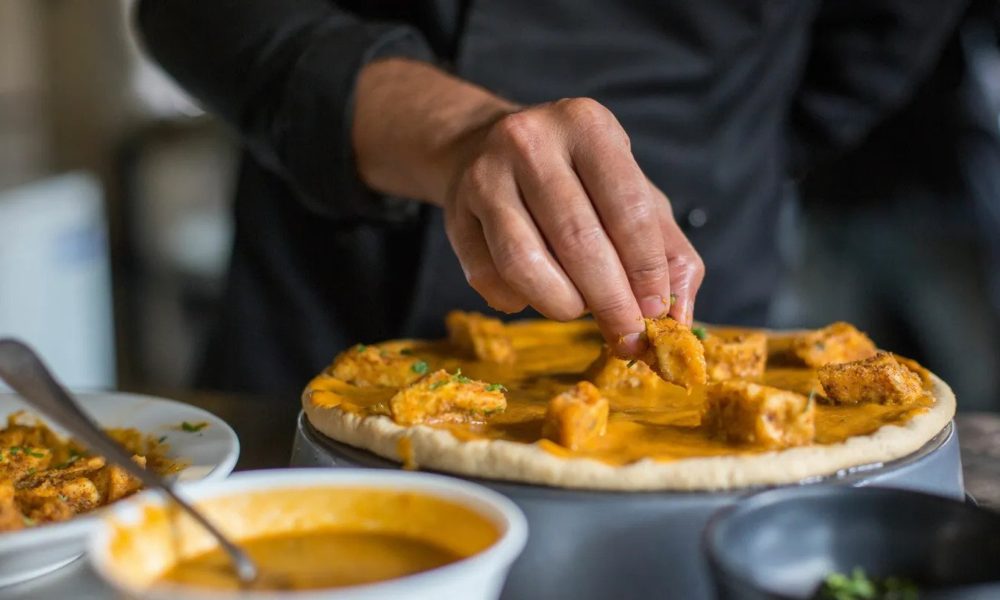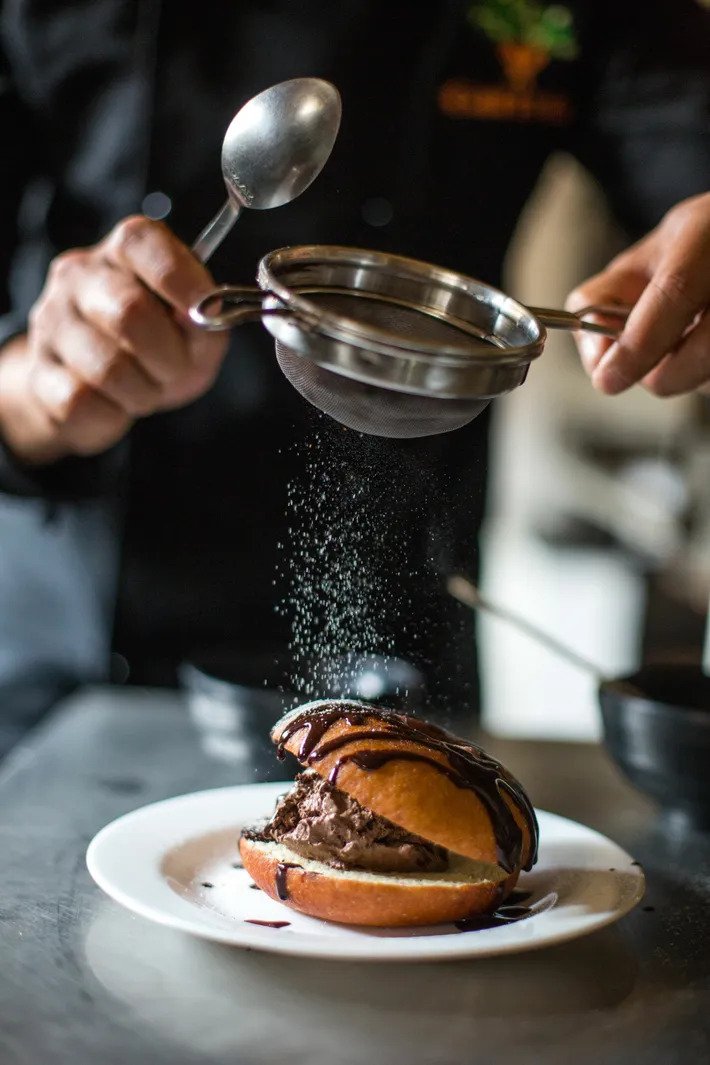



NationalGeographic.co.uk PUBLISHED 11 JAN 2021, 16:45 GMT
BY LIZ DODD PHOTOGRAPHS BY HAJRA AHMAD
It’s known for being India’s tech capital, but Bengaluru is also arguably the country’s best city for vegetarians and vegans, with a truly vibrant meat-free dining scene.
Buttery dosa drenched in coconut chutney, fluffy idli dipped in mild yet addictive sauces.
South Indian snack food is luscious and languid, with flavours that sing of the Keralan coast, and spicing as mellow as Goa trance music. Yet, in the city of Bengaluru, India’s Silicon Valley, this is food eaten not in beach bars but standing — accompanied by a shot of sweet coffee and a copy of The Times of India.
A wealthy garden city of flowering vines and star jasmine, palaces, temples, perpetual spring and eternally gridlocked traffic, Bengaluru has seen an influx of tech companies in recent decades. As a result, the pace of life in the city — formerly called Bangalore — has accelerated at a rate that must have surprised even its most bullish entrepreneurs. Even rickshaws can be ordered on Uber now.
Bengaluru’s darshinis (vegetarian, self-service snack bars) were seemingly made for this moment. The first, Cafe Darshini, was founded in 1983 at the start of Bengaluru’s tech boom. It offered the Western fast food restaurant model, only reimagined for northern Karnataka state’s predominantly Hindu — and therefore largely vegetarian — population. It started a trend, and there are now more than 5,000 darshinis in Bengaluru. Almost by accident, it’s become one of the most vegetarian-friendly cities in the world.
Darshini is breakfast food, so, as a cool dawn breaks over the city on my first morning in Bengaluru, I make my way through humming streets to Brahmin’s Cafe, a darshini cafe. After overconfidently dousing my vada (a savoury lentil doughnut) with scorching sambar (chilli sauce), I try to tame the heat by dipping chunks in cooling coconut chutney. Eventually, I get the balance just right, enjoying each bite of soft, spice-soaked sponge. In the time it takes me to do this, a group of children come and go, dodging three lanes of scooters and rickshaws to make it back to school before the bell finishes ringing. I’m in no hurry, though, and wander to the enormous, 19th-century church next door, somewhat incongruously dedicated to St Patrick, where vases of tropical flowers are being prepared for a wedding.
For lunch, the dosa (a delicate rice-flour pancake) is just one of the menu items I sample at India’s best dosa bar: Mavalli Tiffin Rooms, on Lalbagh Road. The 21-course set menu on the wall behind the cashier is written in Kannada — Karnataka’s most widely spoken language — and turns out to be for the restaurant’s famous thali. It’s not a purist’s darshini joint — it’s too fancy, with table service and seating — but it specialises in darshini staples like dosa and sambar.
Founded in 1924, and frozen in time shortly afterwards, the restaurant has tiled side rooms in which I can see men working dough into roti as I’m led upstairs to the ‘Family Room’ — the sign on the door a throwback to the Roaring Twenties, when women and children dined separately from men. The segregated seating policy is no longer enforced, although I notice the room is mainly full of women and children, waiting with polished tiffin trays in front of them. With so few men present, I wonder if they have their own private tiffin room out the back.
Then the performance starts: a carefully choreographed dance of waiters with dishes of curries and sambars and dhals, stacks of poori (a puffed-up, deep-fried bread) and dosa. Sweet, sticky rice pudding arrives halfway through the meal, along with tangy rice combined with yoghurt as a palate cleanser. The 21-course meal takes just 20 minutes — and costs less than £3. The waiting room is overflowing by the time I leave, chewing beeda, a herbal digestif, as I go. I cross into Lalbagh Botanical Garden to watch monkeys clambering around its 19th-century glasshouse in the warm, late-afternoon sun.
On the other side is Gandhi Bazaar, a riotous street market where sadhus (holy people) run across the road selling blessings to merchants. At the end of the street, where the smell of frying spices cuts through the perfumed flower garlands being prepared for puja (worship), I find myself at one of Bengaluru’s most famous darshini restaurants, Vidyarthi Bhavan. I perch on the end of a table and ask my neighbour, Manisha — who I can just about hear over the cacophony of sizzling hot plates frying dosa and coffee wallahs shouting to one another — whether this is the lunch or dinner rush. “Neither,” she replies, a chutney-soaked idli held delicately in her fingers. “It’s darshini.”
Although I’m still stuffed from my 21-course lunch, I can’t resist taking her lead, ordering a pair of idli so soft and pillowy they immediately absorb the curry they’re served with. But before I take a bite, I remember breakfast, and drizzle them generously with coconut chutney.

The next day, I prepare for lunch by lying on a table that’s also a harp, while, in the candlelight, a woman plays scales on a vertical xylophone. Justbe, a vegan restaurant and wellness centre, offers sound therapy as a kind of aperitif — something that’s par for the course in Bengaluru’s innovative vegan scene, I later discover. It may be a city powered by nuclear coffee shots and fast food, but there’s a counter-movement here, which is seeing vegetarian darshini culture blossom into a city-wide, slow food revolution. Bengaluru has more than 100 vegan and vegan-friendly restaurants, plus India’s first vegan hostel, a vegan homecooked dinner delivery service and a politician, Sowmya Reddy, who’s a vegan and animal rights activist.
“Bengaluru is unique in India, in that it isn’t letting the Western narrative of veganism dictate its culinary resurgence,” Prachi Jain explains over lunch, while I attempt to stir myself out of a post-gong bath reverie. Prachi runs vegan tour company Escape To with her business partner Pradeep Krishnappa. “In Goa, for example, you find a lot of places that do avocado smoothie bowls and so on, because that’s what attracts yogis and Westerners,” she adds. “Bengaluru is different: it’s really proud of its heritage and has this mindset of figuring out how to veganise Indian recipes first.”
Mock meat — ‘bleeding plant-based burgers’, vegan sausages, and so on — isn’t popular here. For Prachi and other followers of Jainism, their faith forbids eating anything that even resembles meat. “For many religious vegetarians, mock meat is kind of repulsive,” Prachi explains. “So vegans here don’t really think about creating alternatives for meat; they’re into using forgotten foods, figuring out how we can incorporate millet and other heritage grains back into the diet, using our grandmothers’ recipes, working out how we can use vegetables and lentils in a different way,” she explains.
We visit The Green Path, an organic cafe and health food store, where the smell of cashew paneer bubbling in hot ovens reaches all the way to the rooftop allotment, an oasis of herbs and vegetables overlooked by skyscrapers. We’re welcomed into the shop with a traditional blessing and are sprinkled with flower petals. This never happens on a trip to Whole Foods. All this, along with Justbe’s yoga studios and gong baths, can feel a little like a SoCal cliche until you remember that the West appropriated this from India, not the other way round.
Veganism was popularised in Bengaluru by a local nutritionist, Dr Nandita Shah, who promotes plant-based diets as a way to treat diseases and conditions — particularly diabetes and high cholesterol, both of which can be by-products of the often high-fat, dairy-rich and sugar-heavy Indian vegetarian diet. Justbe’s owner, Nidhi Nahata, is one of Dr Shah’s disciples — a convert to veganism after attending a 21-day whole foods retreat that significantly lowered her high cholesterol.
“When I opened two-and-a-half years ago, the vegan scene was just getting started,” says Nidhi. “I gave a lot of talks about veganism and health, I worked hard, and I started to see a ripple effect. It was a real risk, because we aren’t just vegan, we’re oil-free and plant-based.”
Had Nidhi not pointed out that the food at Justbe was oil-free, I wouldn’t have noticed. Over the course of our indulgent, four-hour lunch, I mop up a rich dhal makhani (made with black lentils) with a nutty, amaranth roti, chasing that with steaming spoonfuls of quinoa biryani. Somehow, I still have room for a nibble of brownie to finish.
“Most of our visitors are locals,” Nidhi says, “and they can’t taste a difference between our plant-based food and traditional food — like heavy, ghee-laden dhals and curries — but they say they feel completely different afterwards.”
For me, the proof is, literally, in the pudding: I’ve booked high tea at Crave by Leena,
a vegan bakery and cafe in a leafy suburb.
A few hours later, I’m sitting cross-legged on a plump cushion. I want to interrogate Leena, an Indian pastry chef, about the challenges of vegan patisserie, but I can’t. I’m too distracted by the butterscotch sponge she’s made: moist, toothsome and topped with a light buttercream, it’s one of the best cakes I’ve ever eaten.
“We culture our own vegan butter and cream cheese, and make our own milk,” Leena explains when I ask what the secret is. “And we make our own flour from amaranth, brown rice and dhal. In other countries, you can pick up substitutes everywhere. Here, you can’t. Everyone that does anything vegan-related has to create everything from scratch, so we help each other out.”

On Leena’s recommendation, I visit Carrots the next day. Founded in 2013, Bengaluru’s first vegan restaurant has gone on to become a place of pilgrimage for the country’s plant-based community. Its owner, Susmitha Subbaraju, is a bundle of energy; she beams at me from beneath her ‘veganosaurus’ chef’s hat as we split a doughnut ice cream burger, which is just as gratuitous as it sounds. Her signature dishes are Indian classics — chewy, cashew-and-raisin malai kofta in gravy (see recipe, previous page), and gulab jamun, a syrup-soaked sponge.
“Bangalore has always been a melting pot of languages and cultures, so the atmosphere here is very welcoming and chilled out,” she tells me. “When somebody starts something different, people are willing to try it.”
Susmitha, who’s been vegetarian all her life for religious reasons, converted to veganism when she decided that the treatment of animals in the dairy industry didn’t sit comfortably with her spiritual commitment to do no harm. But convincing Indian vegetarians to go vegan is, she tells me, a huge challenge: dairy is effectively sacred for Hindus, and strongly connected to Lord Krishna. “People are very, very afraid when you first tell them ‘no milk’,” Susmitha says. “It’s a very shocking thing for them to imagine.”
Part of Susmitha’s mission is to create alternatives to dairy-heavy comfort foods; having started lunch with a plant-based buttermilk — a surprisingly tangy, herbal yogurt drink — we end with pungent curd rice.
I ask Prachi whether vegans can really experience all that Bengaluru has to offer. What about darshini culture, the ghee-soaked, rambunctious vegetarian scene that exists alongside the city’s vegan scene? Challenge accepted, she and Pradeep take me to VV Puram Food Street, one of the most famous markets in India, for dinner. I inelegantly devour whole bhel (crunchy pastry shells stuffed with onions and herbs and soaked in tamarind juice) and millet roti; dosa; and akki roti, a thick rice pancake layered with crunchy vegetables, before the rupee drops.
The market, adjacent to a Hindu temple, is completely vegetarian. Most of it is naturally vegan, and anything that isn’t — such as dosa, which would usually be cooked in ghee — can be veganised by wallahs, who treat my dietary requirements with the same respect with which they treat those of the vegetarian holy men who queue alongside me. At the end of the market, outside the temple, vibrant, pro-vegan graffiti proclaims ‘Be Fair: Be Vegan: the Bengaluru Brigade for Animal Liberation’. We pose for a photograph in front of it, then merge back into the crowd of monks and mothers, toddlers and tourists, all of us indistinguishable in the bustle of Bengaluru’s genre-redefining food scene.
1. Dosa
These rice pancakes, made from a batter fermented for 18-plus hours, can be either paper-thin or thick and fluffy. The most popular type, masala dosa, is stuffed with mashed potato, spices and curry leaves. Best eaten drenched in spicy sambar and coconut chutney.
2. Idli
Fluffy lentil cakes perfect for soaking up every last drop of the spicy curry they come with, idli (above) are dosa’s distant cousins — both are made out of fermented rice and dhal batter.
3. Masala vada
Indulgent lentil donuts made from a batter seasoned with spices, cumin seeds and curry leaves. Deep-fried until just crisp on the outside but still soft and chewy on the inside, they’re usually served with a fresh coconut chutney.
4. Akki roti
These roti are unique to Karnataka, Bengaluru’s home state, and are usually served for breakfast. They’re made by mixing rice flour with chopped onions, fresh coconut, spices and grated vegetables (often bottle gourd), then frying until crisp.
5. Paniyaram
A way to use up leftover idli and dosa batter, paniyaram are deep-fried rice-and-lentil dumplings with a moist, slightly fermented taste (thanks to the batter) and a savoury outside.
Served at Carrots restaurant, these tofu-and-potato dumplings are served in a rich, spiced gravy.
Makes: 2
Takes: 40 mins
Ingredients
For the koftas:
45g tofu, grated
60g mashed potato
1 tsp wholewheat flour
1 tbsp cornflour
450ml oil, for frying
For the gravy:
3 tbsp sunflower oil
¼ onion, chopped
2 green chillies, sliced
1 tbsp ginger-garlic paste
200g chopped tomatoes
3 tbsp cashew powder
¼ tsp turmeric powder
¼ tsp garam masala
¼ tsp ground cumin
¼ tsp ground coriander
¼ tsp ground cinnamon
3 tbsp fresh coriander leaves
1 tsp salt
¼ tsp black pepper
¼ tsp red chilli powder
chapatis or rice, to serve
Method
1. Begin by making the koftas. Mix the tofu, mashed potato and wholewheat flour in a bowl, then season. Mix well, then roll into golf ball-sized balls and coat with the corn flour. Heat the oil in a pan and deep-fry the koftas until golden-brown.
2. To make the gravy, heat the oil in a pan over a medium heat, then add the onion and fry until golden-brown. Add the green chillies and ginger-garlic paste and fry until the oil separates.
3. Tip in the chopped tomatoes, cashew powder, turmeric powder, garam masala, cumin powder, chili powder, coriander powder, cinnamon powder, salt and pepper, then mix well and cook for 5 mins. Pour in 1 cup water, cover and cook over a low heat for 15 mins.
4. Add the koftas and most of the coriander leaves (reserving 1 tsp for a garnish) and simmer for 5 mins. Pour into a serving bowl, garnish with the remaining coriander leaves and serve with the chapatis or rice.
Getting there
Bengaluru is typically served non-stop by BA, and with one stop by Emirates and Air India.
Where to stay
OYO Townhouse, near Garuda Mall, has double rooms from 4,148 rupees (£44) a night, B&B.
How to do it
Bengaluru-based Escape To offers small group tours. The 10-day A Vegan Adventure in South India includes Bengaluru and costs $2,250 (£1,736) in 2021, without flights.
More info
incredibleindia.org
Published in Issue 10 (winter 2020) of National Geographic Traveller Food
Originally Published online at => https://www.nationalgeographic.co.uk/travel/2020/12/bengaluru-for-vegetarians